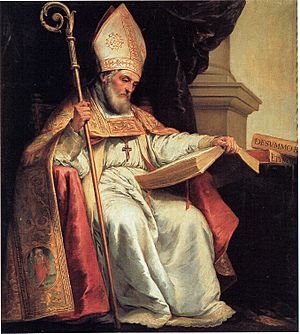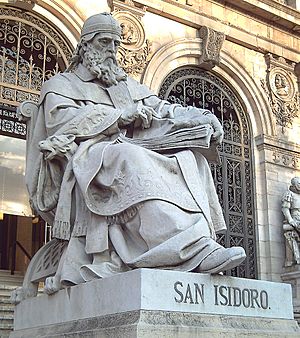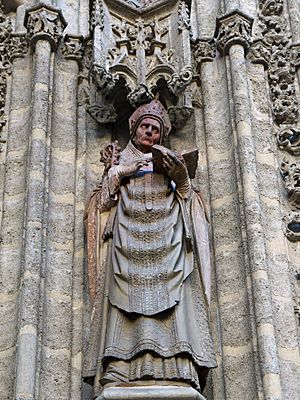Isidore of Seville facts for kids
Quick facts for kids SaintIsidore of Seville |
|
|---|---|

St. Isidore of Seville (1655), depicted by Bartolomé Esteban Murillo
|
|
| Bishop, Confessor, and Doctor of the Church | |
| Born | c. 560 Cartagena, Spania |
| Died | 4 April 636 (aged 75–76) Seville, Visigothic Kingdom |
| Venerated in | |
| Canonized | Pre-Congregation |
| Feast | 4 April |
| Attributes | Bees; bishop holding a pen while surrounded by a swarm of bees; bishop standing near a beehive; old bishop with a prince at his feet; pen; priest or bishop with pen and book; with Saint Leander, Saint Fulgentius, and Saint Florentina; with his Etymologiae |
| Patronage | Students, the Internet, computer users, computer technicians, programmers (all electronic patronages are unofficial)
Philosophy career |
|
Notable work
|
Etymologiae |
| Era | Medieval philosophy |
| School |
|
|
Main interests
|
Grammar, rhetoric, mathematics, medicine, law, languages, cities, animals and birds, the physical world, geography |
|
Notable ideas
|
Isidoran map |
|
Influences
|
|
|
Influenced
|
|
Isidore of Seville (born around 560 – died April 4, 636) was an important Spanish scholar and archbishop of Seville. He is often called "the last scholar of the ancient world."
Isidore lived during a time when old traditions were fading. He helped convert the Visigothic kings from a different Christian belief (called Arianism) to Catholicism. He was a close advisor to King Sisebut. Isidore also played a big role in important church meetings called the Councils of Toledo.
After he died, Isidore became famous for his book, Etymologiae. This was like an encyclopedia that saved many writings from ancient times. Without his work, these writings might have been lost forever. This book also helped set rules for using punctuation marks like the period and comma.
Sometimes, Isidore is called Isidore the Younger. This is because people thought there was an earlier writer named Isidore of Córdoba.
Contents
Life of Isidore
Childhood and Learning
Isidore was born in Cartagena, Spain. His parents, Severianus and Theodora, came from important families. They were key in helping the Visigothic Kingdom change from Arianism to Catholicism. The Catholic Church honors Isidore and all his siblings as saints:
- His older brother, Leander of Seville, was the Archbishop of Seville before Isidore.
- His younger brother, Fulgentius of Cartagena, became a Bishop in Astigi.
- His sister, Florentina of Cartagena, was a nun.
Isidore went to school at the Cathedral of Seville. This was the first school of its kind in Spania (ancient Spain). Teachers there taught subjects like grammar, rhetoric, and math. Isidore studied hard and learned Latin very well. He also learned some Greek and Hebrew.
For two centuries, the Goths ruled Spain. During this time, many old Roman traditions and ways of learning slowly disappeared. But the Visigoths still respected some parts of Roman culture.
Becoming Bishop of Seville

When his brother Leander died in 600 or 601, Isidore became the Archbishop of Seville. As bishop, he immediately became a strong supporter of monks.
Isidore wanted to unite the different groups of people in the Visigothic kingdom. He worked to blend the old Roman ways with the newer Visigothic culture. He used religious teachings to help achieve this goal. He also worked to bring different Christian beliefs together.
Archbishop Isidore also used education to fight against the decline of learning. He made Seville a center for learning. He introduced his people to the ideas of Aristotle long before others in Europe did.
Important Church Meetings
Isidore led several important church meetings called councils.
In November 619, he led the Second Council of Seville. This meeting discussed the nature of Christ. It helped to clarify Christian beliefs.
In December 633, Isidore led the Fourth National Council of Toledo. All the bishops from Spain attended this meeting. Isidore was very influential in its decisions.
Because of Isidore, this council ordered all bishops to start schools in their main church cities. These schools were like the one Isidore attended in Seville. They taught Greek, Hebrew, and the liberal arts. This helped to spread education throughout the Visigothic Kingdom.
Death
Isidore of Seville died on April 4, 636. He had served as Archbishop of Seville for more than 32 years.
Isidore's Writings
Isidore wrote many books in Latin. His writing style was clear and simple. It also showed the growing influence of Visigothic traditions.
The Etymologiae
Isidore's most important work is the Etymologiae. It is also known as the Origines. This huge encyclopedia has 448 chapters in 20 volumes. It was the first Christian encyclopedia of its kind.
In this book, Isidore collected information from many ancient Roman books. He summarized and organized this knowledge. Many parts of ancient learning were saved because of his work. Without it, they would have been lost forever.
The Etymologiae was highly respected. People thought it contained "practically everything that it is necessary to know." Because it was so popular, many older books were not copied anymore and eventually disappeared. Isidore's book became the main source of knowledge for scholars.
This work inspired many other encyclopedias during the Middle Ages. It was the most popular book in medieval libraries. It was printed many times, showing its popularity even during the Renaissance. For a long time, Isidore's Etymologiae was how Western Europeans learned about the ideas of Aristotle and other Greek thinkers.
Other Writings
Isidore wrote over a dozen other major works. These covered topics like mathematics, holy scripture, and monastic life. Some of his other important books include:
- Historia de regibus Gothorum, Vandalorum et Suevorum: A history of the Gothic, Vandal, and Suebi kings.
- Chronica Majora: A universal history of the world.
- De natura rerum (On the Nature of Things): A book about astronomy and natural history.
- De ecclesiasticis officiis: About church duties.
Honors and Legacy

Isidore is considered one of the last great thinkers of the ancient Christian world. Many scholars call him the most learned man of his time. He had a huge impact on education during the Middle Ages. His friend, Braulio of Zaragoza, believed Isidore was sent by God to save the Spanish people from the decline of civilization.
In 653, the Eighth Council of Toledo praised him as "The extraordinary doctor, the latest ornament of the Catholic Church, the most learned man of the latter ages, always to be named with reverence, Isidore." In 1722, Pope Innocent XIII officially declared him a Doctor of the Church.
Isidore was buried in Seville. His tomb became an important place for people to visit. In the 11th century, his remains were moved to the Basilica of San Isidoro in León. Today, some of his bones are in the cathedral of Murcia, Spain.
Isidore is mentioned in Dante's famous poem, Paradiso. He is listed among other great theologians.
The University of Dayton named its online learning system after Saint Isidore. His image is also on the crest of the Sevilla FC football club.
There is even a group called the Order of St. Isidore of Seville. It was formed in 2000 to honor Saint Isidore as the unofficial patron saint of the Internet. The group also promotes Christian chivalry online.
Images for kids
See also
 In Spanish: Isidoro de Sevilla para niños
In Spanish: Isidoro de Sevilla para niños
- Saint Isidore of Seville, patron saint archive





